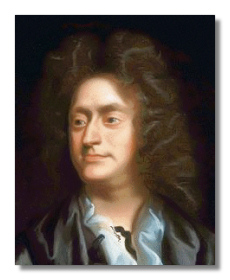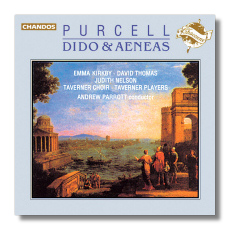
The Internet's Premier Classical Music Source
Related Links
- Recommended Recordings
Recommended Biographies
Recommended Scores
CD / DVD Reviews - Audio Samples:
 (MIDI)
(MIDI) - Voluntary
-
Find CDs & Downloads
Amazon - UK - Germany - Canada - France - Japan
ArkivMusic - CD Universe
Find DVDs & Blu-ray
Amazon - UK - Germany - Canada - France - Japan
ArkivMusic-Video Universe
Find Scores & Sheet Music
Sheet Music Plus -
- The Purcell Project
by David Harvey - Purcell's Works
by Lewis Morton
Recommended Links
Site News
Henry Purcell

(1659 - 1695)
Seldom heard outside of England, Henry Purcell is nowadays considered a prime mover of baroque classical tradition, easily standing beside Johann Sebastian Bach, Antonio Vivaldi, and George Friedrich Handel in degree of accomplishment. Although believed to have never set foot outside of his native country, Purcell is today enjoyed by performers and listeners everywhere to summits that he could never have imagined in his own lifetime.
Little is known about Purcell as a man, since documentation is lacking and concerns over posterity were not so intense as today. Purcell was probably born in 1659; his memorial tablet at Westminster Abbey lists date of death as November 21, 1695, in his 'thirty-seventh year.' It is uncertain where he was born (although Westminster is likely) and which elder Purcell was his father. Thomas Purcell and an older Henry are noted as musicians in King Charles II's Gentlemen of the Chapel Royal, but who actually sired the world-renowned composer is unclear.
Despite his vague parentage, Purcell was unquestionably shaped by a musical family. He also began his career upon the English Restoration's arrival, which followed an eleven-year period under Cromwell when open performance of music was banned. In 1669 or 1670, Purcell was admitted to the Chapel Royal choir school at Whitehall, a children's program subsidized by the King. Purcell was trained as a singer, player, and composer while accompanying grown choristers of the Chapel Royal during service. English music, pushed underground by the Commonwealth, was in a rebuilding stage; the choral repertoire focused on sixteenth-century anthems by such masters as William Byrd, Thomas Tallis, and Orlando Gibbons while Charles II encouraged new music in the style of Louis XIV's court, which he heard during exile in France.
For approximately one year, Purcell received composition lessons from Pelham Humfrey, who became master of the choir school in 1672. Humfrey, an emerging talent in his mid-twenties, had spent recent years on a grant from King Charles to study the music of France and Italy. This instruction probably had great impact upon Purcell's later aesthetic. Purcell's voice broke at age fourteen, but he had won enough favor with the Chapel Royal to become an apprentice keeper of instruments. He gained valuable knowledge of baroque orchestration, though Purcell received no salary for his work. Purcell advanced to organ tuner at Westminster Abbey two years later, where he was reunited with former keyboard teacher John Blow.
Purcell already had a sizeable reputation for writing anthems, particularly 'verse anthems' that resemble the modern choral cantata. This music included string passages, which helped him to become paid composer for 'His Majesty's violins' in 1677, replacing deceased friend Matthew Locke. Charles II's string group consisted of 24 members, excluding double bass; the violin had just replaced the viol as primary string instrument despite its association with the 'frivolous' dance music of continental Europe Purcell also succeeded Blow as organist of Westminster Abbey in 1679 and became co-organist of the Chapel Royal in 1681, which required him to perform at service and accompany the King's musicians at Windsor. .
His compositional activity was intense, writing sonatas, fantasias (then called 'Fancies'), and music for the Church. As was common for Purcell's time, a small fraction of his music was published and little has survived. Perhaps his best-known work is the Ode for St. Cecilia's Day (Hail, bright Cecilia), written in 1692 to celebrate the patron saint of music. He also supplied music for the coronation of King James II in 1685 and the funeral of Queen Mary II in 1695. Purcell wrote music from a practical standpoint, fulfilling commissions by theater groups to enhance his income. His opera Dido and Aeneas was written for a Chelsea girls' school in 1689; it is one of the first English dramas to emphasize singing rather than speaking. Purcell won further stage acclaim in 1690 for The Prophetess (or Dioclesian), an ostentatious play after Beaumont and Fletcher.
Although Dido and Aeneas steered English opera towards its current form, economics forced Purcell to compose for 'Semi-operas,' or plays that combined singing with spoken dialogue. Semi-opera was still the design preferred by general audiences and Purcell could not rely entirely upon private commissions for income In 1691, he composed for John Dryden's plays Amphitryon and King Arthur before involvement in 1692 with The Fairy Queen, an anonymous adaptation of Shakespeare's A Midsummer Night's Dream. These dramas are of considerable fame today. Unfortunately, Purcell also wrote music for numerous semi-operas that have faded into obscurity. Despite the consistent quality of Purcell's work, many plays are of dismal literary value and have never been revived.
Purcell wrote instructional texts and commentaries that offer a glimpse into how music was performed in his era. These writings, however, are far from complete; there are no existing diaries or notebooks by Purcell and his surviving correspondence is a letter asking for back pay as keeper of the King's instruments. Proper performance of his music has been a dilemma, as manuscripts supply little beyond the notes to be played. Entrenched in the seventeenth century, markings such as tempi and dynamics were only given in specific instances and ornamentation of notes was frequently left to the performer. This has made Purcell's music a fertile area of research, particularly in resolving manuscript questions.
Purcell seems to have married 'Frances' in 1680 or 1681, with whom he fathered six children; three of the six died in infancy. On November 21, 1695, Purcell was gravely ill, perhaps from a high fever, and wrote a last will and testament (which survives) just hours before his passing. He was given a state burial and is entombed near the organ in Westminster Abbey. During much of Purcell's life and subsequent decades, English society concerned itself with 'new' music rather than compositions of the past. Purcell's works, especially for theater, were played in the years immediately after his death but faded by the mid-eighteenth century. As a result, important manuscripts were misplaced or entirely lost. The Fairy Queen manuscript, for instance, was declared missing in 1700 and not recovered until 1901. The manuscript of Dido and Aeneas remains unfound and survives only as two reprints with numerous errors. Virtually all of Purcell's organ music has disappeared and is now left to our imaginations.
Yet what remains of Purcell has shaped English music to a profound degree. The Purcell Society, formed in 1876, has worked to revive his music by publishing scores and encouraging performance. Purcell's music enjoyed resurgence as the twentieth century began, when composers such as Ralph Vaughan Williams, Gustav Holst, and George Butterworth launched their careers. Decades on, Englishmen such as Benjamin Britten (especially in his Young Person's Guide to the Orchestra), Michael Tippett, and Malcolm Arnold have written music with considerable homage to Purcell Despite a lack of written history, enough of Purcell survives for the musical world to appreciate his talents and grand design.
Author's note: Due to varying opinion, the information supplied in this article may differ from particular leading sources while coinciding with others. The main source used for this article was Henry Purcell: The Theory of his Life and Work by Imogen Holst (London: Boosey & Hawkes, 1961). In resolving issues such as year of employment or year of premiere, I have favored Ms. Holst's book due to her highly-regarded knowledge of baroque music in England and her access to key documents of the period. ~ Paul-John Ramos
Recommended Recordings
Anthems
- Complete Anthems and Services Vol. 1/Hyperion CDA66585
-
Nicholas Witcomb, Jerome Finnis, Philip Hallchurch (trebles); James Bowman (countertenor); Charles Daniels (tenor); Michael George, Robert Evans (basses)/Choir Of New College, Oxford
- Complete Anthems and Services Vol. 2/Hyperion CDA66609
-
Nicholas Witcomb, Daniel Lochmann, Philip Hallchurch, Timothy Bowes (trebles), James Bowman (countertenor), Rogers Covey-Crump (tenor), Michael George (bass)/Choir Of New College, Oxford
 Dido and Aeneas (opera)
Dido and Aeneas (opera)
- Dido and Aeneas/Chandos Chaconne CHAN0521
-
Emma Kirkby, Judith Nelson (sopranos), Jantina Noorman (mezzosoprano), David Thomas (bass-baritone), Andrew Parrott/Taverner Players & Taverner Choir
- Dido and Aeneas/London-Decca Legends 466387-2
-
Dame Janet Baker, Monica Sinclair (altos), Patricia Clark, Eileen Poulter, Rhianon James, Catherine Wilson (sopranos), Raimund Herincx (bass), Anthony Lewis/English Chamber Orchestra, St. Anthony Singers
Fantasies
- 15 Fantasias, Z. 732-747/BIS CD-1165
-
London Baroque
 Trio Sonatas for Strings & Continuo
Trio Sonatas for Strings & Continuo
- 7 Sonatas à 3 & Pavans/Chandos CHAN8591
-
Purcell Quartet
- 5 Sonatas à 3, 2 Sonatas à 4, Pavans & Fantasias/Chandos CHAN8663
-
Purcell Quartet
- 8 Sonatas à 4 & Voluntaries/Chandos CHAN8763
-
Purcell Quartet
- 12 Sonatas à 3/Harmonia Mundi HMC901439
-
London Baroque
- 10 Sonatas à 4/Harmonia Mundi HMC901438
-
London Baroque














